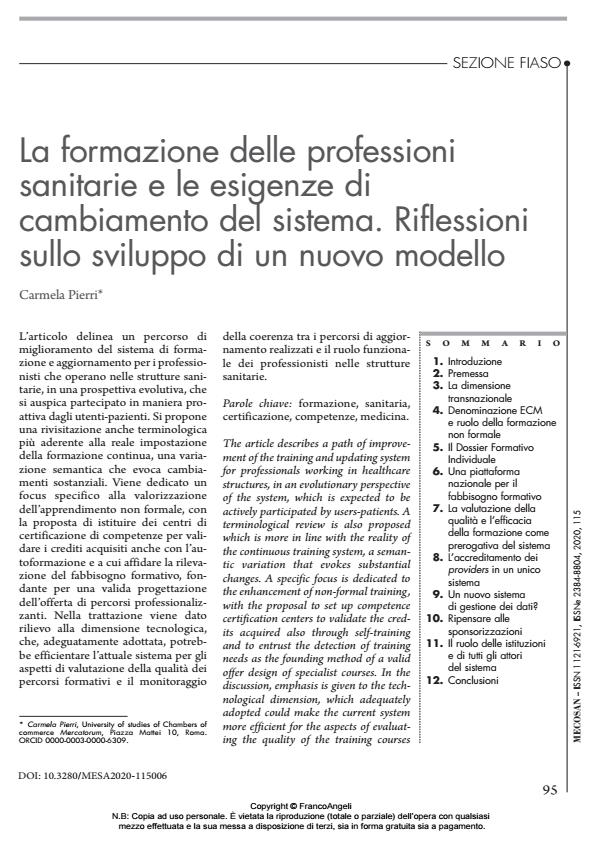La formazione delle professioni sanitarie e le esigenze di cambiamento del sistema. Riflessioni sullo sviluppo di un nuovo modello
Journal title MECOSAN
Author/s Carmela Pierri
Publishing Year 2021 Issue 2020/115 Language Italian
Pages 22 P. 95-116 File size 252 KB
DOI 10.3280/MESA2020-115006
DOI is like a bar code for intellectual property: to have more infomation
click here
Below, you can see the article first page
If you want to buy this article in PDF format, you can do it, following the instructions to buy download credits

FrancoAngeli is member of Publishers International Linking Association, Inc (PILA), a not-for-profit association which run the CrossRef service enabling links to and from online scholarly content.
The article describes a path of improvement of the training and updating system for professionals working in healthcare structures, in an evolutionary perspective of the system, which is expected to be actively participated by users-patients. A terminological review is also proposed which is more in line with the reality of the continuous training system, a semantic variation that evokes substantial changes. A specific focus is dedicated to the enhancement of non-formal training, with the proposal to set up competence certification centers to validate the credits acquired also through self-training and to entrust the detection of training needs as the founding method of a valid offer design of specialist courses. In the discussion, emphasis is given to the technological dimension, which adequately adopted could make the current system more efficient for the aspects of evaluating the quality of the training courses and monitoring the consistency between the updating courses carried out and the functional role of the professionals in the healthcare companies.
Keywords: Ttraining, health, certification, skills, medical.
- Bloom B.S. (2005). Effects of continuing medical education on improving physician clinical care and patient health: a review of systematic reviews. International Journal of Tecnology Assessment in Health Care, 21(3): 380-385.
- Boulay C. (2000). From CME to CPD: Getting Better at Getting Better. British Medical Journal, 4: 320:393.
- Branco A., Cohen K.B., Vossen P., Ide N., Calzolari N. (2017). Replicability and reproducibility of research results for human language technology: introducing an LRE special section. Language resources and evaluation, 51(1): 1-5.
- Cervero R.M., Gaines J.K. (2015). The impact of CME on physician performance and patient health outcomes: an updated synthesis of systematic reviews. US National Library of Medicine National Institutes of Health.
- Maioli S., Mostarda M.P. (2008). La formazione continua nelle organizzazioni sanitarie tra contributi pedagogici e modelli operativi. Milano: McGraw-Hill.
- Spangler B. (2003). Win-Win, Win-Lose, and Lose-Lose Situations, Beyond Intractability. Eds. Guy Burgess and Heidi Burgess. Conflict Information Consortium, University of Colorado, Boulder. Posted: June 2003.
- Walsh K. (2018). Self-directed continuing medical education at the point-of-care: implications for cost and value. Ann Ist Super Sanità, 54(1): 58-60.
- Wolfgang K., Michael I., Bernhard R., Peter S. (2012). Object-Oriented Application Development Using the Caché Postrelational Database. Milano: Hoepli.
- Yadav N., Yadav A., Bansal J.C., Deep K., Kim J.H. (2018). Harmony Search and Nature Inspired Optimization Algorithms Theory and Applications, ICHSA 2018. Heidelberg (Germany): Springer Nature.
Carmela Pierri, La formazione delle professioni sanitarie e le esigenze di cambiamento del sistema. Riflessioni sullo sviluppo di un nuovo modello in "MECOSAN" 115/2020, pp 95-116, DOI: 10.3280/MESA2020-115006